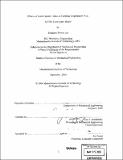Effects of joint capsule tissue on cartilage degradation in an in vitro joint injury model
Author(s)
Lin, Stephanie Norris, 1980-
DownloadFull printable version (29.31Mb)
Other Contributors
Massachusetts Institute of Technology. Dept. of Mechanical Engineering.
Advisor
Alan J. Grodzinsky.
Terms of use
Metadata
Show full item recordAbstract
Osteoarthritis is a degenerative disease of the whole joint that affects an estimated 20.7 million Americans. Traumatic joint injury causes an increase in risk for the development of osteoarthritis. A previously developed model system involving co-culture of injured cartilage with joint capsule tissue or joint capsule conditioned medium was used to simulate the interaction of injured cartilage with other joint tissues. Experiments were carried out to characterize this model in greater detail and to quantify the release of GAG and changes in chondrocyte biosynthesis that occur as a result of co-culture. Model system parameters that were varied included the type of culture medium used, the duration of culture, and the size of the joint capsule tissue that was used. Experiments were also done to more carefully characterize properties of the joint capsule tissue such as GAG content, DNA content and variations in these properties with location. Attempts were also made to identify an unknown factor released by the joint capsule tissue that was potentially responsible for the observed decrease in chondrocyte biosynthesis as a result of co-culture. While this factor was not identified, convincing evidence suggested that it was not IL- 1 or TNF-a. Systematic evaluation of this model system led to the conclusion that measurement of loss of total sGAG, alone, was not a definitive outcome measure, since it was difficult to distinguish the sGAG lost from cartilage from sGAG that was lost by the joint capsule tissue. The results suggested that more specific outcome measures such as gene expression of the cartilage or capsule and western analysis and biochemical analysis of matrix fragments lost to the medium would provide a more definitive interpretation of the interaction between joint capsule tissue and injured cartilage.
Description
Thesis (S.M.)--Massachusetts Institute of Technology, Dept. of Mechanical Engineering, 2004. Includes bibliographical references (p. 160-162).
Date issued
2004Department
Massachusetts Institute of Technology. Department of Mechanical EngineeringPublisher
Massachusetts Institute of Technology
Keywords
Mechanical Engineering.